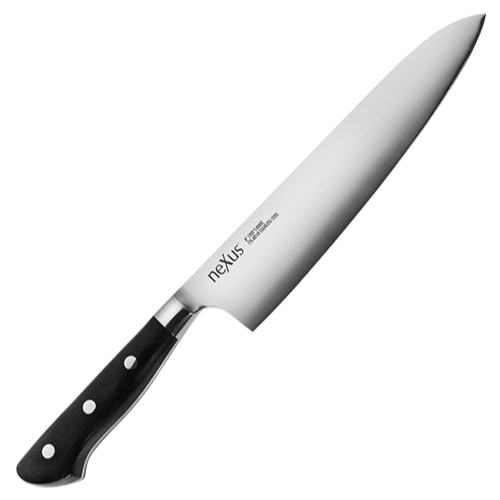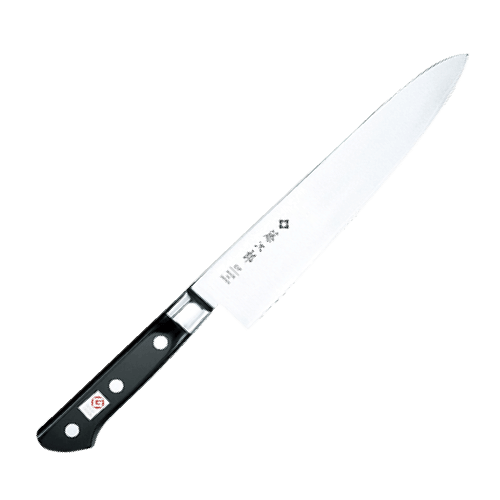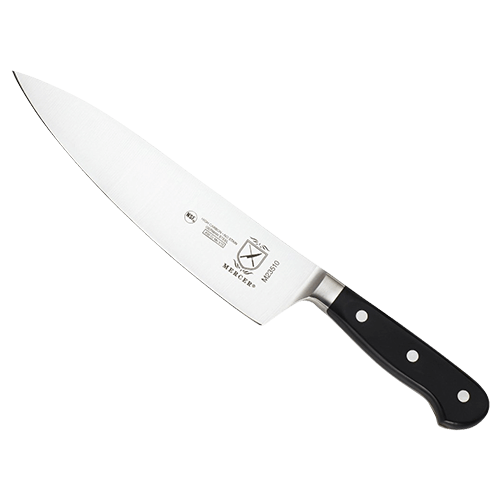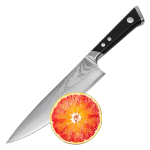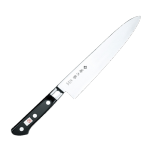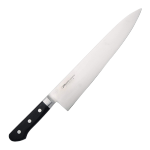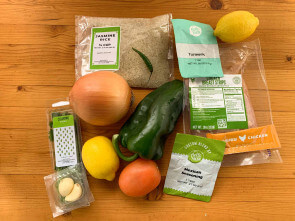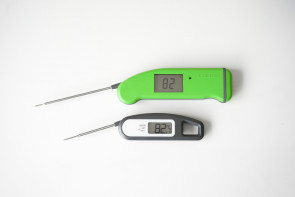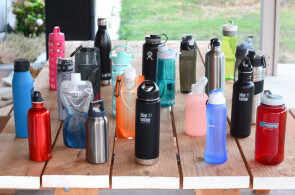
The Best Kitchen Knives
Our cutlery enthusiast took eleven of the best kitchen knives for under $100 and put them through two months of testing. The Nexus – BD1N is our winner, with a new steel that keeps an edge for a long time while also being easy to care for. If you’re looking for a bargain, the Greater Goods – 0556 is also great. The Tojiro – DP is Japan’s thin, hard-wearing wonder that slices all day, but it isn’t the bargain it used to be.
Our cutlery enthusiast took eleven of the best kitchen knives for under $100 and put them through two months of testing. The Nexus – BD1N is our winner, with a new steel that keeps an edge for a long time while also being easy to care for. If you’re looking for a bargain, the Greater Goods – 0556 is also great. The Tojiro – DP is Japan’s thin, hard-wearing wonder that slices all day, but it isn’t the bargain it used to be.
Table of contents
- How we selected finalists to test
- Compare the best kitchen knives
- Important features to consider
- How we tested
- Top performance: Nexus – BD1N
- Best value: Greater Goods – 0556
- Best Japanese knife: Tojiro – DP Gyuto
- Best German-style knife: Mercer – Renaissance
- Other finalists we tested
- The bottom line
How we selected finalists to test
When we looked around for opinions of high-end knife enthusiasts, it was clear that value is a very relative scale among knife buyers. In this thread on Kitchen Knife Forums, a “beater” is a $240 handmade piece for one enthusiast, while for another it’s a dollar-store knife that he customized with his collection of sharpening gear.
Our researcher for this review has been collecting and using knives of all sizes since he got his first Wenger Swiss Army “MacGyver knife” at age five or six. Though he long ago gave up his dream of becoming a bladesmith himself, he’s made a few cooking knives. He grew up around a lovely set of Henckels, and he’s been peripherally aware of the movings and shakings in the kitchen cutlery world.
Studying reviews from Cook’s Illustrated, Serious Eats and Wirecutter gave us a list of must-test blades, but also quickly shaped a bell curve for our assessment of the best kitchen knives for the money.
We also made a deep dive into online discussion among the chefs at Cheftalk and the never-ending knife discussions on reddit and the Kitchen Knife Forums.
Then, to take a step back from the hype, we talked to some more wizened experts for their takes on what a cook really needs in a knife.
After consulting with Dave Martell (long-time kitchen knife sharpener, knife maker and owner of the Kitchen Knife Forums) and Chef David Hendricksen, national culinary director for the Art Institutes Culinary School, we put together a list of criteria and began comparing retail offerings.
We analyzed the stats and reviews of 39 models and narrowed that group down to 12 finalists. We settled on three groups, each with slightly different goals and priorities:
Budget knives: These finalists are a set of rough-and-ready blades with molded handles that were as cheap as $13. Utility knives like this one from Kiwi brand are often the real workhorses in professional kitchens, but we wanted to show options more refined than that. We included plastic-handle knives from Victorinox and Wüsthof because they’re so well-regarded by other reviewers, but we also included a much cheaper knife from Mercer to get a fair comparison of what’s possible on a shoestring budget.
Mid-tier knives: These are knives you can give to a friend as a wedding gift without blowing a $50 budget, but also without being embarrassed by cheap-looking molded handles. The ideal knife in this category is also a great starter blade for someone who wants to up their fine-cooking game but has no intention of learning about steel types or mirror-polished edges.
Upgrade knives: We opened up the purse strings a little bit to see what you get for slightly more than a mid-tier knife. A $40 knife should already cut well if you keep it sharp, so we looked specifically for better, harder steel that will hold a razor-sharp edge longer than ordinary knives do.
Knife nerds of all stripes will probably protest that we aren’t even testing $100 or $200 knives (not to mention the hallowed Kramer designs or other $300+ options you’ll find at fine retailers). But if you’re going to shell out more than $100 for a knife, you should really feel it in-hand for yourself.
We can steer you through the important specs and pitfalls of mass-manufactured knives, but it’s very difficult to tell you what your favorite balance, edge profile and handle shape are going to be. At price brackets above $100, those are the refinements you should be looking for, more a matter of taste than qualities we can list on a chart.
Compare the best kitchen knives

| Knife | Price | Finish Quality | Handle Comfort | Overall Performance |
|---|---|---|---|---|
| 1. Nexus - BD1N | $$$ | ☆☆☆☆ | ☆☆☆☆ | ☆☆☆☆☆ |
| 2. Greater Goods - 0556 | $$ | ☆☆☆☆ | ☆☆☆☆ | ☆☆☆☆ |
| 3. Tojiro - DP Gyuto | $$$$ | ☆☆☆☆ | ☆☆☆☆ | ☆☆☆☆☆ |
| 4. Mercer - Renaissance | $$ | ☆☆☆☆☆ | ☆☆☆☆ | ☆☆☆ |
| 5. Misono - Molybdenum Gyuto | $$$$ | ☆☆☆☆☆ | ☆☆☆☆ | ☆☆☆☆ |
| 6. Mercer - Millennia | $ | ☆☆☆ | ☆☆☆☆☆ | ☆☆☆ |
| 7. Victorinox - Fibrox | $$ | ☆☆☆ | ☆☆☆☆☆ | ☆☆☆ |
| 8. Wüsthof - Pro Cook's Knife | $$ | ☆☆☆☆ | ☆☆☆☆☆ | ☆☆☆ |
| 9. Tramontina - Pro | $$ | ☆☆ | ☆☆☆☆ | ☆☆ |
| 10. OXO - Good Grips Pro | $ | ☆☆☆☆ | ☆ | ☆☆ |
| 11. IKEA - 365+ | $ | ☆☆☆☆ | ☆☆ | ☆☆ |

Important features to consider
We talked to two kitchen knife experts to narrow down a list of the most important characteristics in a knife. Dave Martell runs the kitchen knife forums, and they get a lot of requests for knife recommendations from new members. We came up with these core questions that you need to ask yourself to make a good knife choice:
Intended use: What’s the most important job for your knife? Will you be slicing meat? Chopping root vegetables? Will you ever split an acorn squash? A knife you use for eight hours every day might have different features than something you only use for half an hour every week.
Profile: Do you want the edge of the knife to be in full contact with the cutting board to get more control, or do you want to “rock” it through the food to get more power?
Edge geometry: Every knife collector has a preference for the final edge shape. To sum it up, there are basically two paths: First, there are thick, obtuse edges that are robust and easy to re-sharpen. Those more interested in maximum slicing precision prefer thin, acute edges that will slice like a laser but chip more easily if you abuse them. Thin edges also take longer to re-sharpen, and often require practiced skill with a bench stone.
Handle size, shape and materials: A handle you hate with a great blade in it will still be a knife you hate. Do you have big hands? Do you prefer a certain way of gripping a knife? Sadly, it’s hard to tell which handles you’ll like best from a picture, but you can see the relative sizes in our lineup photos.
Only after you’ve answered questions about those preferences does Martell suggest looking into other factors. Here are some commonly-mentioned attributes:
Balance: If you like to move quickly and make rapid cuts, a light knife with neutral balance can feel more nimble. If you want more power and you’re cutting for long sessions, you might prefer a blade-heavy knife that keeps weight on the cutting board. An eight-inch blade typically has a neutral or handle-heavy balance, while longer knives will be more and more blade-heavy.
Full tang or hidden tang: The steel your knife’s handle is attached to is called the tang. If you can see the line of steel extending the full length and width of the handle, it’s called a full tang. It’s cheaper for manufacturers to cut the tang short and mold a handle around it, though plenty of lovely and expensive knives are made with partial or hidden tangs. The biggest influence of this choice is on balance and weight: a full tang means more weight in the handle and moves the balance point closer to you.
Stamped vs. forged: Thirty years ago, if a blade was stamped or cut out of a sheet cookie-cutter style it was usually a sign of a very cheap knife, while all the “good” knives were forged to shape from a bar or rod. These days, that distinction is entirely gone. Both forged and stamped-and-welded knives are now made with bolsters, and stamped or laser-cut steel is used in some of the very best collector’s knives.
Steel hardness and toughness: If a manufacturer chooses to make their knives harder, the edges will last longer, but that also makes them more prone to chipping and makes sharpening take longer. Most popular knives are kept on the softer side so a bent-over edge can be burnished back to shape with a honing steel. See our tests below for a look at how big that difference can be when an edge is thinned out.
Steel alloy and wear resistance: Steel is mostly just iron with a pinch of carbon, but other alloying elements can make it even better for certain tasks. More carbon means the steel can get harder, and more chromium adds stain resistance, but in high-carbon stainless the chromium and other elements like vanadium also form extra-hard carbides. Carbides help the steel resist wear, but they make thin edges more prone to breaking. Finding a balance of all these elements and managing heat treatment carefully is how the master bladesmiths stay ahead of the curve.
Surface texture: Hammered finishes can show off the connection that your knife has with the smith who forged it. That said, there are plenty of lovely hand-hammered blades that are then carefully polished flat, so a hammered finish is almost always a decorative choice. The texture doesn’t add anything to the function of the knife unless the pattern is dramatically deep, in which case it might help keep food from sticking to the blade.
Patterned blades: Pattern-welded steel is made up from layers of steel that have been stacked, folded and welded together. This specialized material is often called “Damascus” steel because of the resemblance to Wootz steel from India and the Middle East, though it’s made more like Japanese tamahagane or Nordic pattern-welding. The advantages of these methods are entirely obsolete now that we have precise control over steelmaking, but many collectors still love the look and the tradition behind the pattern.
Layers vs. monosteel: Many smiths in Japan prefer to make blades that have layers of softer metal on the sides. Smiths we talked to agree that there’s no specific benefit to the end user unless you especially want a high-carbon steel core with stainless sides to make maintenance easier.
Hollows and stick-resistant finishes: There are a few different ways to approach food sticking to the blade. A true Granton edge (invented by Granton Cutlery) for slicing meat is actually wavy all the way to the edge, something you basically never find on a chef’s knife. Other manufacturers will grind out hollows in the side of their blades and sometimes call them “granton edges.” In Japanese cutlery, you’re more likely to see hand-forged divots or a dished-out grind profile called “urasuki” that keeps food from sticking. We didn’t buy any chef’s knives with textured blades, but see our testing results below for what we found out about food release when slicing with chef’s knives.
How much should you spend?
So far as performance and value goes, there’s often a big gap between a mass-produced $100 knife and a handmade $300 specialty piece. When choosing a really high-end knife, you can often pick and choose important factors: A steel with specific characteristics, attractive handle materials and a profile or sharpening style that matches your intended use.
If you don’t have specific preferences and you want to get the most for your money, though, the difference between a mass-produced $40 knife and most $100 knives is surprisingly small. In some ways this is a testament to the quality of modern $40 knives: Steel quality, factory sharpening and heat treatment are pretty well standardized at this level, with few exceptions. It’s not the best performance possible, but that mostly means you’ll just have to sharpen more frequently. Check out our kitchen knife sharpener review to see what the options are.
A $100 knife isn’t doing very much extra to pull out ahead; most are made from the same steels on the same production lines as their budget brethren. You’ll often get a more prestigious name, and a nicer-looking handle, but the cutting edge itself will usually be identical between a plastic-handle knife and a $150 model.
In German knives, you’ll typically see a bigger performance improvement by having an expert cutler re-sharpen a $40 knife to a thinner edge than you would by paying for an up-market model from the same manufacturer. The days when a forged knife from a German manufacturer was clearly superior to their budget line are long gone; the differences are now mostly in handles.
Above $140 you can find the best-selling brands used by chefs who make a long-term investment in their tools: the ubiquitous Henckels, Mac, Shun, as well as premium-steel offerings from newer brands like Yaxell. The steel in German-made knives typically won’t be any different than most $40 knives even at this price, but if you look carefully you should be able to find steels that get harder than the ubiquitous German X50CrMoV15 (also called 1.4116) Stainless.
If you want hand-forged, you can sometimes find good, basic knives at less than $200. You won’t get anything really artisanal, like the alluring “hamon” line from careful edge-hardening, until you go above $200-300.
Dave Martell sharpens and sells some very expensive, very beautiful knives, but he warns people not to get caught up in the hype and miss the bigger picture: “Too many people get hung up on what steels are used and what fancy crap has been added to lure you in. What matters so much more than that is if the knife is made to perform for its intended task. If that isn’t addressed first then what steel the knife is made from will have little meaning.”
What is a chef’s knife?
The tradition of the chef’s knife goes back for centuries, but we learned when talking with our experts that the prototype for nearly every modern chef’s knife can be traced through the designs used by two different Sabatier families in Thiers, France, in the 19th Century. The curve of the edge has morphed and evolved slightly as we’ve developed specific chopping and slicing techniques, but chef’s knives all feature a “dropped” edge that gives your fingers room when you’re chopping on a cutting board.
The recent influx of Japanese cuisine, Japanese chefs and cross-pollination between Japanese and German manufacturing technique has heavily influenced popular trends in chef’s knives.
To summarize trends: German manufacturers pioneered the use of stainless steel that is easy to take care of, but not very hard. You can use a honing steel on most Western chef’s knives and bring back a fairly sharp edge by burnishing and re-aligning the steel that rounds off or rolls over, but it won’t stay that sharp for more than a day or so of chopping veggies. You can keep using the steel to bring back the edge, but eventually it gets too thick to cut effectively and needs thinning.
In contrast, Japanese chefs expect extra-hard steel finished to a mirror-polished edge, often with a chisel-shaped asymmetrical bevel rather than the same sharpening angle on each side of the blade. The edges can be thinner, since the expectation is that chefs will be making careful, precise cuts with gyuto knives, while heavy-handed vegetable chopping is reserved for a cleaver-style knife. These edges last longer, but the hard steel doesn’t respond well to burnishing with a honing rod, so you’ll need to learn how to sharpen them yourself or send them away.
Both the German kochmesser and the Japanese gyuto shape are still inspired by the French Sabatier knives. The biggest difference is in handles. German knives tend to have a full-width steel “tang” sandwiched between riveted handle “scales,” while the traditional “wa” handle in Japan is a single, round piece of outer material with a skinny tang inside that you can’t see. Another characteristic feature of European designs is the bolster, a thickened section of steel that covers the transition from blade to handle.
These days, most Japanese manufacturers also make the Western-style “yo-handle gyuto” with the familiar full-tang-and-rivets construction. (The Misono and Tojiro we tested are perfect examples.) Ironically, Wa-handle designs are now very popular among American and British custom knife makers.
Chopping, slicing and edge thickness

Another big difference between popular chef’s knives today is in their belly and edge thickness. When you look at a blade in profile, a larger radius in the arc of a knife edge is basically the definitive trait of a German chef’s knife. More of that “belly” curve makes the knife better suited to rocking motions against the cutting board. If the arc is flatter, the knife will have more board contact and can slice long sections with a push or slicing motion.
The thickness of steel behind the final sharpened bevel is probably the biggest influence on the way a knife handles. If you want a stiff blade that can help you crunch through hard root vegetables with its weight, or something that will chop through chicken leg bones, a thicker blade is what you’re looking for. On the other hand, if you’re trying to slice ripe tomatoes without squashing them, thinner “laser” knives will present less drag and resistance as they slide through.
How long is too long?
If you’re slicing something like a large roast, a longer blade will help you work efficiently, cutting as deeply as possible with each stroke. If you’re mostly chopping carrots, though, you usually don’t need to make any slicing movement and you can easily cut all the way through with one motion, whether rocking or push-cutting. A dedicated vegetable knife is usually shorter, from five to seven inches, while a dedicated slicer is often as long as 12 inches.
Most home cooks want a chef’s knife that’s good for both types of cutting, so the real question is your cutting board. If you’re limited to an eight-inch cutting board, you might want to look for seven-inch versions of these chef’s knives just so you’ll have an easier time maneuvering. If you’ve got a beautiful 24-inch butcher-block, a 10-inch knife will have plenty of room to maneuver and will be able to mince a large pile of veggies more quickly.
Chef Hendricksen puts it a slightly different way: “Big knives scare people and an 8-inch is a good size to get work done and not be so intimidating. It’s the starter knife I recommend. If someone is proficient with an 8-inch, they should be able to use other sizes.”
How should I hold a chef’s knife?
If you’re just starting out with a chef’s knife, you might be unsure about the best way to hold it. So long as you keep your fingers clear of the edge, there’s nothing specific that you need to learn other than how comfortable the knife feels in your hand while making the cuts or slices you need.
Slicing by pushing or drawing the edge of the knife through the food you’re cutting is one of the most efficient ways to use a sharp knife, especially when you’re cutting something soft or tricky to hold.
Most chefs favor the “pinch” grip with the blade itself between thumb and knuckle: This angle is just right so that the back-and-forth slicing movement comes from the strength of your arm, not your wrist or fingers.
Knives with smaller bolsters and simple handle shapes are generally easier to use in this grip, and the Japanese “wa-handle” is becoming very popular partly for this reason.
As you can see from the video above, a blade with a deep belly curve almost gets in its own way when push-cutting into the board or making short, quick slices. A flatter edge profile is usually preferred, since the whole edge will finish the cut against the cutting board at the same time.
That said, if you’re making really long draw-slices, like julienne or matchstick cuts, extra curvature can make things easier (think of a pizza cutter).
When chopping, even just small, precise chops where the blade rocks against the cutting board, many prefer to keep their fingers wrapped securely around the handle. You don’t need anything fancy to chop well, but if you’re putting a lot of force into your chop for stringy or hard materials, a contoured or cushioned grip can be nice.
The bigger difference here comes from blade shape: A full, rounded “belly” makes rocking the knife that much easier.
Can stainless steel be good enough?
About 100 years ago, cutlery manufacturers started using chromium-rich “stainless” steels in knives. The appeal is obvious: Stainless steel prevents tough-to-clean rust spots, and the chromium layer that forms naturally on the surface of stainless steel also keeps the steel from leaving a metallic taste in food.
Without careful heat treatment, though, stainless steel is less ideal for knife edges than simple carbon steels or specialized “tool steels.” Early stainless steel had a terrible reputation for being soft, and even with modern heat treatment methods the old recipes for 420 and “surgical” stainless are often derided as “junk.”
New alloys with more and more carbon appeared on the scene and allow the steel to get harder than that early stainless steel, and as more carbon is added the chromium and other elements also combine with it to create hard, wear-resistant carbide grains within the steel.
With more extreme carbide-rich alloys, steel is more wear-resistant, but also more prone to chipping when edges are thin.
The industry standard is x50CrMoV15 stainless steel (also listed as 1.4116 or frequently as “German stainless”), with a middling amount of carbon and usually a hardness of only 55 or 56 on the Rockwell scale compared to 59 or low 60s for other knives and tools. This low hardness prevents chipping, and ensures you can still easily sharpen the edge by running it across a steel honing rod to bend or scrape it back to shape.
Those who seek to push the envelope look to other alloys that allow thinner edges and better wear resistance. AUS-8 and its evolved cousin, VG-10, are the gold standards for Japanese stainless knives.
Often considered an ideal balance of toughness and wear resistance, VG-10 has just enough carbon to allow more hardness and wear-resistant carbides that will give a busy chef a few days more between sharpening touch-ups.
The big name to look out for if you’re seeking a specific alloy is AEB-L (the trademark from Austrian steel mill Böhler-Uddeholm) and 13c26 (from Swedish mill Sandvik.) This steel was formulated for use in razors; it’s basically the finest-grained stainless steel out there, which means edges resist chipping even when the steel is extra hard.
Sadly, we didn’t find any affordable knives to test that use AEBL, though rumor has it that’s what Zwilling uses it in their little-known Diplome chef’s knife and Misono uses it in the frequently-sold-out UX10.
If you don’t mind the staining and want something as easy as possible to sharpen, Carbon steel knives are still available, both from European and Japanese factories. If anything, they’re easier to find now than they were 10 years ago due to growing interest among chefs and enthusiasts.
If you’re buying a high-end piece, makers like Bob Kramer, Murray Carter and Dave Martell will often use carbon steel with a refined and customized heat treatment to get top performance from a knife. You’re going to want to clean a knife like that very diligently anyhow, so the lack of stain-resistance is often less of a concern. Some chefs even cherish the dark patina that develops on their prized carbon steel blades.
For the most part, the real advantage that carbon steel used to have over stainless — namely, a heat treatment that makes knives hard enough for extra-thin edges that aren’t brittle — is missing in mass-produced carbon steel blades. Factory-made blades in the West are almost always tempered on the softer side to maximize toughness and to make sharpening easier. Bringing modern stainless steels to an equivalent level of performance is now common practice, and you don’t gain much by stepping back in time.
How we tested
We spent three months using these knives in a home kitchen. We made Thanksgiving and Christmas dinners, stew and soups, and diced over fifteen pounds of onions.
We bought a five-pound bag of carrots and chopped them with wet hands to see how the grip of each knife changed in stressful situations. We also sliced yams to see how the knives fared in hard vegetables with enough cross-section that thicker blades will wedge stuck.
Slicing Performance
| Knife | Onion Cutting | Yam Slicing | Food Release | Handle Comfort |
|---|---|---|---|---|
| Nexus - BD1N | ☆☆☆☆☆ | ☆☆☆☆ | ☆☆☆ | ☆☆☆ |
| Greater Goods - 0556 | ☆☆☆☆ | ☆☆☆☆ | ☆☆☆ | ☆☆☆☆ |
| Tojiro - DP Gyuto | ☆☆☆☆☆ | ☆☆☆☆ | ☆ | ☆☆☆☆ |
| Mercer - Renaissance | ☆☆☆☆☆ | ☆☆☆☆☆ | ☆ | ☆☆☆☆ |
| Misono - Molybdenum Gyuto | ☆☆☆ | ☆☆ | ☆☆☆ | ☆☆☆☆ |
| Mercer - Millennia | ☆☆☆ | ☆☆☆☆☆ | ☆ | ☆☆☆☆☆ |
| Victorinox - Fibrox | ☆☆☆☆ | ☆☆☆ | ☆☆☆ | ☆☆☆☆☆ |
| Wüsthof - Pro Cook's Knife | ☆☆☆☆☆ | ☆☆ | ☆ | ☆☆☆☆☆ |
| Tramontina - Pro | ☆ | ☆☆ | ☆☆☆ | ☆☆☆☆ |
| OXO - Good Grips Pro | ☆ | ☆ | ☆☆☆☆ | ☆ |
| IKEA - 365+ | ☆☆☆ | ☆ | ☆☆☆ | ☆☆ |
In the kitchen, easy slicing is the quality that’s most important. Even if you have a knife that’s perfect in every other way, a blade that won’t slice through food is just going to stay in a drawer.
One feature of kitchen knives that’s often talked about, but rarely quantified, is the thickness of a blade. We measured each blade with a micrometer to check the thickness at the spine as well as the thickness immediately behind the edge, where it can start to wedge in food if it’s too thick. Thinner blades slice better but are also more flexible, which is a slight liability if you’re using a lot of force when cutting hard root vegetables.
Weight is another consideration: A light blade is easier to lift and move quickly, but a heavier blade can help you chop and slice efficiently. We also checked how far toward the tip or handle the balance point is, measuring from the heel of the blade. There’s no perfect weight or balance for a knife, as that’s definitely a matter of preference, so we hope our chart will help demonstrate the differences if you can’t hold the knives for yourself.
The standout performers in slicing tests are thin blades with extra-thin edges. The Tojiro – DP and Nexus – BD1N are great slicers, as we expected, but the thin edge of the Mercer – Renaissance was a nice surprise. It used to be that budget knives were just flat pieces of sheet steel sharpened on one edge, but all the blades we tested are ground across the whole blade to make an elegant, thin wedge. Even the most disappointing knife in this group can cut tomatoes without squashing them, so long as it’s kept sharp.
The Misono – Molybdenum Steel Gyuto is a rare exception to the thinner-is-better rule: The asymmetrical edge that it comes with is ideal for some push-cutting tasks once you get used to it, but for peeling, carving and other tasks where you need to control the width of the section you’re slicing off, it steers your hand quite a lot.
Food release
The way some vegetables stick to a knife blade when you’re cutting thin slices can be annoying. We compared all of these chef’s knives with an old santoku-style chopping knife that has hollows ground into the side of its blade, and we’re reassured that these features are nearly always a placebo at best. The one spec that seems to matter here is the cross-section of a blade’s cutting edge: the thickest edges we tested did seem to stick less than the thinner blades.There are specialized slicing knives that have specific features to “hack” this problem, but they’re generally not as versatile as a regular chef’s knife. If you’re slicing roast all day a true Granton edge is probably worth looking into, and if you’re making paper-thin veggie slices for delicate displays you should check out the specialized Japanese “usuba” knife style.
Factory sharpening and ease of maintenance
| Knife | Tested Weight (Oz) | Balance from Heel (Inches) | Factory Edge Angle (Degrees) | Thickness Behind Edge (Inches) | Spine Thickness (Inches) |
|---|---|---|---|---|---|
| Nexus - BD1N | 7.4 | Handle 0.6 | 14 | 0.014 | 0.092 |
| Greater Goods - 0556 | 8.6 | Handle 0.7 | 18 | 0.014 | 0.089 |
| Tojiro - DP Gyuto | 7.0 | Handle 0.2 | 18 | 0.012 | 0.076 |
| Mercer - Renaissance | 8.3 | Handle 0.7 | 12 | 0.016 | 0.102 |
| Misono - Molybdenum Gyuto | 5.6 | Handle 0.2 | 17L, 25R | 0.012 | 0.077 |
| Mercer - Millennia | 6.2 | Tip 0.2 | 12 | 0.015 | 0.101 |
| Victorinox - Fibrox | 5.9 | Tip 0.2 | 11 | 0.016 | 0.094 |
| Wüsthof - Pro Cook's Knife | 6.5 | Neutral | 11 | 0.015 | 0.088 |
| Tramontina - Pro | 8.8 | Handle 0.9 | 16 | 0.014 | 0.109 |
| OXO - Good Grips Pro | 7.6 | Handle 0.7 | 14 | 0.018 | 0.093 |
| IKEA - 365+ | 6.5 | Handle 0.6 | 14 | 0.020 | 0.085 |
After measuring the initial sharpening angle with a goniometer and checking factory sharpness on our BESS tester for the sake of posterity, we killed the edges on a sharpening stone and then re-sharpened them, first by hand to get a feel for how easy each steel sharpens, and then with the winner of our knife sharpener review, the Chef’sChoice – 1520, on its 15 degree setting.
We also used fine-grained ceramic stones on the Spyderco – Sharpmaker to deburr and polish the edges after sharpening. We stropped the edges occasionally with a chromium oxide-loaded leather paddle to see how easy it was to keep an ultra-sharp edge on each steel.
We checked sharpness again after our cutting sessions to see which steels have the best edge retention. The VG-10 on Tojiro – DP Gyuto definitely lived up to its reputation as full-strength Japanese steel, both because of how long the edge lasts and because of how much longer it took to sharpen.
The BD1N steel in the Nexus is a strong performer in a different way: easier to sharpen, slightly less wear resistant. We’re not able to provide a controlled edge retention test, but we think it’s well worth a little bit less wear resistance to get easier sharpening.
After our edge stability and repair tests, the Nexus earned our pick for the best real-world performance, but if you’re cutting into something more abrasive that wears the edge instead of rolling it, you may prefer the VG-10 steel in the Tojiro or Greater Goods knives.
| Knife | Factory Sharpness (1-5) | Wear Resistance (1-5) | Edge Stability (1-5) | Easy Sharpening (1-5) | Steel Alloy |
|---|---|---|---|---|---|
| Nexus - BD1N | ☆☆☆ | ☆☆☆☆ | ☆☆☆☆☆ | ☆☆☆ | BD1N |
| Greater Goods - 0556 | ☆☆☆ | ☆☆☆☆ | ☆☆☆ | ☆☆ | VG-10 |
| Tojiro - DP Gyuto | ☆☆☆☆☆ | ☆☆☆☆☆ | ☆☆☆☆☆ | ☆ | VG-10 |
| Mercer - Renaissance | ☆☆☆☆☆ | ☆ | ☆☆ | ☆☆☆☆☆ | X50CrMoV15 |
| Misono - Molybdenum Gyuto | ☆☆☆☆ | ☆☆☆ | ☆☆☆☆ | ☆☆☆ | AUS8? |
| Mercer - Millennia | ☆☆☆☆ | ☆ | ☆☆ | ☆☆☆☆☆ | X30Cr13 |
| Victorinox - Fibrox | ☆☆☆ | ☆ | ☆☆ | ☆☆☆☆☆ | X50CrMoV15 |
| Wüsthof - Pro Cook's Knife | ☆☆☆☆ | ☆ | ☆☆ | ☆☆☆☆☆ | X50CrMoV15 |
| Tramontina - Pro | ☆☆ | ☆☆ | ☆☆ | ☆☆☆☆☆ | Unknown, x50? |
| OXO - Good Grips Pro | ☆☆☆☆ | ☆ | ☆☆ | ☆☆☆☆☆ | X50CrMoV15 |
| IKEA - 365+ | ☆☆☆ | ☆ | ☆☆ | ☆☆☆☆☆ | Unknown, x50? |
Edge stability
A test of wear resistance is common among knife enthusiasts looking to sort out which steels and heat treatments are superior for cutting abrasive material like cardboard or rope. For a veggie slicer, though, abrasive wear isn’t the primary reason your edge goes away: Instead, pressing the edge into the cutting board (not to mention bone or glass serving dishes) rolls over or chips away the micron-thick edge.
Steel is hardened by heat treatment that changes the structure on a molecular level. When steel is hard, it will still flex just as much as soft steel of the same thickness. (Springs are very hard, but also very thin.) The opposite of hardness is not flexibility, but toughness, more precisely called ductility.
A ductile or tough blade will spring back and forth up to a point, but when you flex it past what its strength can handle a tough blade will permanently bend instead of snapping. Tough steel can even be bent back to shape, though it is weakened. Put another way, hard steel can stand up to slightly more pressure on the edge than soft steel before it’s damaged, but when you push it past the limit harder steel will be more likely to chip.
A fine grain in the molecular structure of the steel allows a thin edge to be hard (so it resists that bending or “rolling” sideways when pushed to the limit) without being brittle. Metallurgist Roman Landes popularized the term “edge stability” in his research to determine which steels are best at holding a thin edge.
Whatever knife you settle on, choosing an edge angle when sharpening that’s appropriate for what you’re cutting is crucial to keeping your knife sharp. Hard material like bone requires a higher edge angle than raw fish does. If you can get a hard-yet-stable steel that doesn’t chip on the materials you’re cutting, though, you can make the edge thinner.
You can measure hardness with the Rockwell test, where a calibrated instrument presses a diamond tip into the steel. It’s tricky, though, to get a consistent reading on thin, wedge-shaped blades (and impossible on laminated blades with soft outer layers). We looked for another test that would directly measure the ability of a knife edge to withstand abuse.
We consulted with metallurgist Larrin Thomas to design a test, inspired by Landes’s methods, that would show differences in the ways our knives resist both rolling and chipping. Larrin is working on his own set of tests for comparing steels, but he suggested adapting the “brass rod test” popularized by bladesmiths like the late Wayne Goddard.

Our test uses a steel rod held by one end at a fixed distance above the edge of a table; the knives were clamped to the table so that the rod rested on the edge at a 30-degree angle. We experimented with weights to find the limits of representative steels. At 15 pounds of weight hanging from the 30-degree rod, soft steels bent into a divot, while brittle steels (like a sample of the ultra-wear-resistant CPM-S90V alloy from one of our tester’s utility knives) broke away in a pretty serious chip.
We took a representative set of our kitchen knives in the different steels (and from different price levels) and thinned out the edge to a uniform 12 degrees per side. This is a more acute edge than any commercial sharpening device will make, but it’s a good benchmark for what you can get when hand-sharpening to maximize slicing ability.
The results are translated to an out-of-five scale in our chart, but we measured each deformation with calipers and again by measuring the width in a macro photograph.
The harder blades made from high-carbon alloys like AUS-8, BD1N and VG-10 were the most resilient in this test, with the smallest deflections from the rod pressing against the edge. This should translate well into resistance to the kind of damage your knife gets from bones, plates and scraping against the cutting board.
We were surprised not to see any damage in the form of chips in this test, since in hard-but-tough tool steels like CPM-M4 (a popular pick for “blade sport” cutting competitions against rope and wood) we had already seen minor chipping when we set up the controls for the test. These kitchen knives, even the ones on the harder end of the scale, are probably tempered specifically to resist chipping.
The softer German-style knives all bent over pretty severely in this test, with bent sections averaging at more than 1 mm. This means that a 12-degree edge (which is close to the factory setting for many of these knives) is probably too acute for general-purpose use with these knives. Our test is quite extreme compared to slicing onions, but it’s a real test of relative strength.
The best score was from the Nexus at only 0.45 mm of damage, and the Tojiro close behind at 0.50 mm. These edges have enough strength that you could sharpen to an even more acute edge if you want razor-blade levels of slicing performance. (The straight razors we’ve reviewed go as low as 7 degrees, which is definitely too thin an edge for these knives.)
Sharpening and repair
After testing and photographing the deformations in the knife edges, we ran them across a carbide pull-through sharpening device (the Brod & Taylor – Classic) to see which steels are easy to repair. This process straightens out the deformation from our test, but only if the thin steel edge is ductile (or “tough”) enough.
The softer German steel in most knives is tempered enough that it reshapes easily with the Brod & Taylor or a steel “honing” rod. Of the harder blades (which aren’t typically sharpened in this fashion), the finer grain in the AUS-8 steel from Misono and the BD1N steel from Nexus also survived realigning to a straight edge. With the more wear-resistant VG-10 blades from Tojiro and Greater Goods, when we sliced some phone book paper after the repair procedure, small chips were easy to feel.

If you want to use waterstones for sharpening, an edge that resists wearing away against your cutting board and an edge that’s easy to sharpen have basically opposite qualities. VG-10 takes more work to sharpen than these other steels, and it’s more fragile, but it’ll hold that edge for longer. VG-10 isn’t as difficult to work with as some crazy-carbide-content alloys used in high-end pocket knives, but still, forget about maintaining it with just a steel.
If you’re ready to invest in a set of fast-cutting water stones for freehand sharpening, or a powered sharpening device like our pick for best sharpener, VG-10 is a great steel. The hardness we saw in these tests hasn’t lead to fragility you should worry about. But, if you want something that you can maintain for months with just a honing rod or a strop, a tougher steel will definitely be a better pick.
The Nexus uses new BD1N steel, which is a great compromise. This knife should resist chipping and other severe edge damage much better than VG-10. It can be maintained with a honing steel, but we still think a sharpener like the Spyderco Sharpmaker is a good idea for keeping the edge in tip-top shape.
Stain resistance
We smeared each of the knives with lemon juice and mustard, and after we cleaned the knives a day later, there was no staining or etching left behind. These steels are all have enough chromium in the mix to meet the classic “stainless” definiton, so it’s not a surprising result.
Top performance: Nexus – BD1N
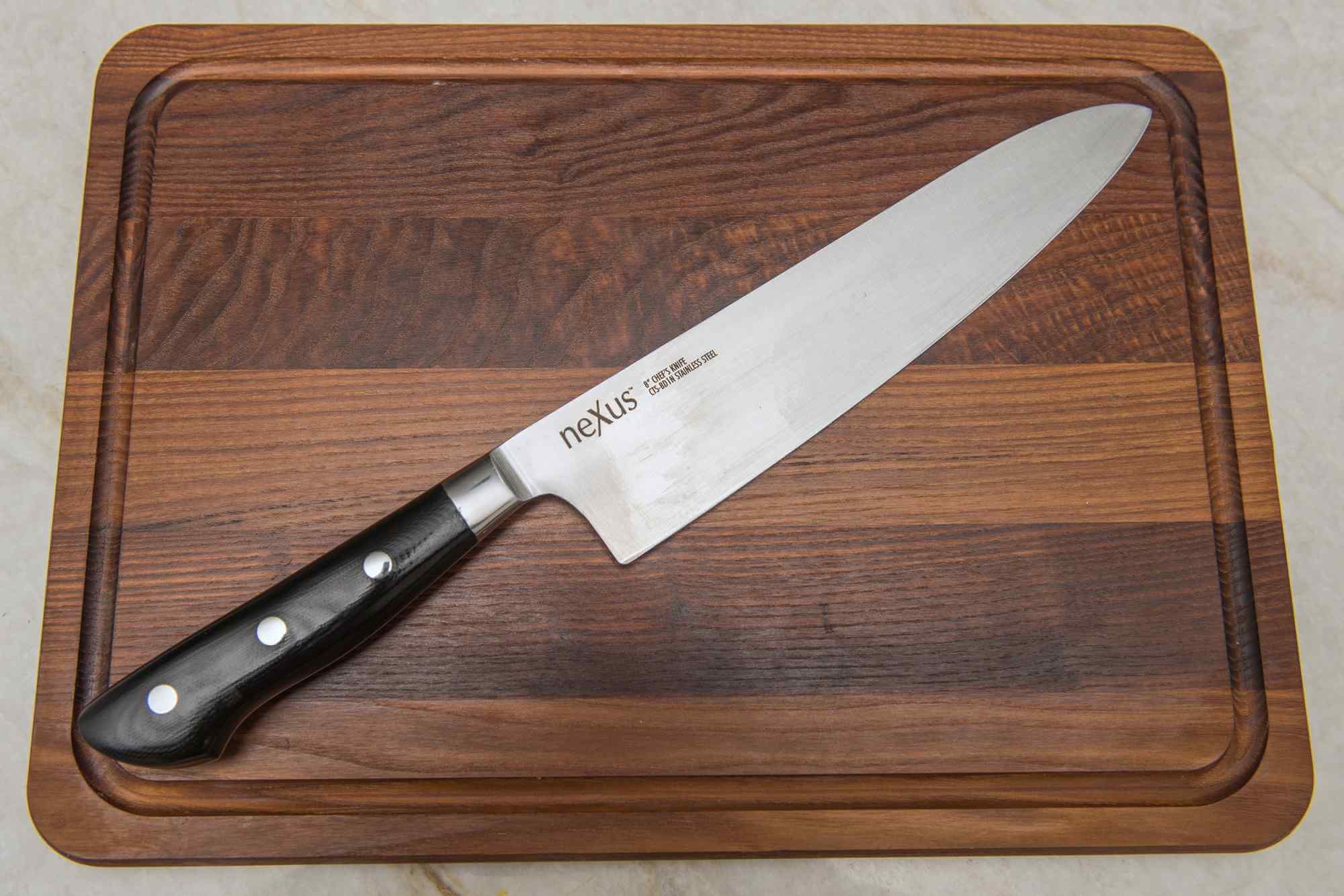
If you want a knife that can hold a sharp edge for longer but is still easy to sharpen, look no further than the Nexus – BD1N 8″ Chef’s Knife. This is a knife designed and manufactured exclusively for CutleryandMore.com. While there are a few other blades on the market made with similar specs, this one comes in at about half the price.
The accepted wisdom in cutlery design has always been that you can only have hard or tough knives, not both. The Nexus doesn’t do anything magical — there are limits to how much abuse this knife can take, and it won’t hold its edge forever — but this knife will require less work to maintain in the long run, and for a home cook that’s a good thing.
The important distinction this knife achieves with its BD1N steel is that you get great edge stability (it won’t blunt as quickly from slamming into a cutting board or hitting a bone) while also being fairly easy to sharpen. The VG-10 steel used in Tojiro’s fan-favorite DP series is also impressively resilient, but it takes more work to sharpen when it eventually wears down.
If you’re accustomed to using a “honing” steel with your knives, the Nexus will actually let you carry on to a certain extent without damaging the edge the way you would most wear-resistant Japanese knives. You’re still better off using a waterstone or even an electric sharpener for maintenance, but if you see rolled-over divots in the edge, the Nexus will tolerate repair strokes to reset the edge.
Best Performance: Nexus - BD1N
Cutlery and More designed this knife to be affordable and innovative. It wins on all counts. There are some finishing flaws that reveal the price point, but the hard-yet-tough BD1N steel is exactly what we were hoping for. It's a good compromise between thin and beefy, and it's easy to take care of.
The handle of the Nexus is made from G-10, the same fiberglass-reinforced resin that circuit boards are cut from. This stuff is basically indestructible unless you hit it hard enough to crack it. We don’t recommend washing any knife in the dishwasher, but this material will stand up to that abuse as well as any other handle.
What about flaws?
There are a few reasons you might not like the Nexus, and they’re considerations you should take seriously.

First, the knife we bought had an obvious blemish along the spine that probably came from a slip when someone was “crowning” that edge with a nice, smooth rounded finish. This is a forgivable blemish on a $60 knife, but if you get one with a mark like this you could probably get it exchanged. We should note that other reviews are quite favorable regarding finish quality.
Second, the handle isn’t our favorite. It’s rounded and polished, which isn’t a bad thing, but the tapered shape doesn’t always lend itself to a secure grip. Even if you’re a pinch-grip acolyte who cares more about the bolster than the handle, the lack of meat at the front half of the handle feels less comfortable for extended use than many of the others we tested.
Finally, this blade feels even thinner than it actually is. We were surprised when we checked and found that the spine thickness is greater than that on the Greater Goods – 0556; it feels more whippy when you’re trying to smash garlic into a paste the way you remember Jacques Pépin doing it. This feeling mostly comes from the narrow transition area right in front of the handle, typical for a “yo-gyuto” East-meets-West handle style.
Key takeaways:
- The Nexus – BD1N is an innovative and affordable knife that stands out from the pack.
- A few scuffs mar an otherwise excellent finish.
- This is a new blade steel that keeps an extra-fine edge without being fragile.
- G-10 handle material will withstand anything, though the polished finish is a bit slippery.
- The weight and grind are a good compromise; neither a clunky beater nor a fragile laser.
Best value: Greater Goods – 0556

The Greater Goods – Nourish 0556 Japanese Damascus Steel 8″ Chef’s Knife is a budget-friendly knife made to match all the specs and features that used to be exclusive to high-end Japanese cutlery.
Pattern-welded steel wrapped around the VG-10 core doesn’t cut any differently or make it a better tool, but it’s a distinctive look some people love. The consistent finish overall is also notable at this price, with no grinder marks or scuffs showing anywhere. The wood-grain pattern of the steel layers will also hide scratches better than a plain, polished blade, but the “road” of core steel next to the edge has been polished to a mirror finish. It’s only an imitation of traditional Japanese craftsmanship, but it looks very impressive.
What makes this cut better than an average chef’s knife is that hard, wear-resistant core. This is the same Hitachi VG-10 steel that’s used by Miyabi, Shun and other better-known Japanese factories in their top-shelf knives. VG-10 has enough carbon that it can get very hard, and alloying elements like vanadium help it resist wearing down for longer than simpler steels.
If you like knives that are light and nimble, this isn’t a top pick. At 8.6 ounces, it’s the second-heaviest knife we tested, and the balance point is more than a half-inch behind the bolster. It’s not unwieldy, and one tester found the weight reassuring, but if you’re spending long days in the kitchen a blade-heavy design will usually make work easier.
The handle design is deliberately modern, rather than mimicking a classic shape, but it works very well. Unlike some knives, the handle isn’t contoured in an awkward way; there’s a gentle taper to the rounded-square cross section. The handle material is polyoxymethylene (POM) plastic — not exactly high-end, but it’s a reliable, durable choice that serves very well on quite a few more expensive knives.
Greater Goods chose a balanced blade grind and a rounded edge profile for this knife, and that means it’s a versatile kitchen tool. It won’t slide through tomatoes quite as easily, but it also feels less flimsy than the Misono, Tojiro and Nexus knives. It’s one-thousandth of an inch thinner behind the edge than the Victorinox, with the same thickness at the spine.
As good as all of those specs are on paper, using steel from Japan isn’t the same thing as having Japanese mastery in heat-treating. This blade had 0.7 mm divots after our edge stability tests, compared to the 0.5 mm dents that Tojiro allowed with the same steel.
That’s still well above the soft German steels at over 1.0 mm, but we’ll speculate that the Chinese factory is deliberately making it softer than the Japanese like it. Sadly, running a conventional hardness test is impossible: The standard Rockwell hardness tester pushes a diamond point into the side of a flat piece of steel, and the other steel layers on the sides of these knives would make that measurement meaningless.
We wish that Greater Goods had tried to get a harder heat treatment instead of spending on the pattern-welded steel and polishing. All things considered, though, it’ll hold an edge for longer than any other knife we’ve seen at this low price.
A downside to VG-10 is that you can’t really bring back a damaged edge with a honing steel the way you can with a softer edge. VG-10 will just make a ragged razor-ribbon at the edge when you try to burnish it.
Instead, you’re much better off sticking with abrasive sharpening: Waterstones are the traditional choice, but a motorized pull-through sharpener that uses abrasive wheels (like our top knife sharpener picks) also works quite well. Make sure to use a sharpener with a 15-degree edge angle, and put masking or packing tape on the sides of the blade to prevent scratching the decorative finish.
If you’re extra-diligent about knife care, the Spyderco Sharpmaker is a great choice for weekly touch-ups and requires less of a learning curve than benchtop stones. That said, you’d definitely want to buy the optional coarser-grade diamond or CBN abrasive rods for repair sharpening if you manage to chip a VG-10 knife; you’d be sharpening for a very long time with the included medium-grit stones.
The fact that this knife includes a well-designed magnetic mounting puck also means this kit has everything you need to outfit a minimalist kitchen. The versatility of the blade style, comfortable handle and low price make this knife an easy recommendation.
Key takeaways:
- The Greater Goods – 0556 is designed to match all the specifications of a high-end knife with some innovative styling at a shocking price.
- VG-10 blade steel is excellent, though here it isn’t hardened as well as it could be.
- This handle is large and heavy, which lends a feeling of security but will slow some chefs down.
- The 0556’s blade shape is good for rock-chopping, and looks unique next to most cutlery.
- The magnetic wall-mount holder is a great bonus.
Best Japanese knife: Tojiro – DP

The Tojiro – DP Gyuto is a perennial favorite among the kitchen knife enthusiasts on the web. A few years ago this knife was even less expensive, but mainstream popularity has brought the price up and made it less of a standout value. The popularity isn’t all negative, though, since this knife is easy to find.
Tojiro tied for the thinnest knife we tested, just 0.012″ behind the edge. The factory edge was one of the sharpest we tested, and it slices both soft and hard vegetables very well.
The Tojiro isn’t going to impress anyone next to a Shigefusa or other hand-finished custom knife, but it has no major flaws. Tojiro only does the bare minimum to smooth rough edges and make the handle comfortable, but it’s a solid version of the classic East-meets-West design. The heel of the blade is left as a sharp 90-degree corner, which some people prefer, but it’s also easy to round off on a sharpening stone if you’re worried about accidentally snagging it on something.
Tojiro doesn’t say what the handle is made from. It seems to be some kind of layered composite like Micarta, and the very slightly raised edges on the rivets mean it’s probably a tiny bit less stable during humidity changes than the G-10 material used on the Nexus.
If there’s a downside to the Tojiro, it’s maintenance. The VG-10 steel has alloy elements that resist wear, which means you won’t have to sharpen it as frequently, but you’re going to have to work harder to sharpen it when that time comes. There are plenty of solutions on the market to getting this blade back to a keen edge, like our favorite electric knife sharpener, but if you want to take a shot at hand-sharpening with a waterstone it’s just that much more work than the other knives we tested.
If you’re using the Tojiro in the kind of kitchen where people are sometimes cutting against ceramics and metal, you’re going to be spending even more time sharpening a blade like this. The Nexus resists damage a tiny bit better and is easier to repair.
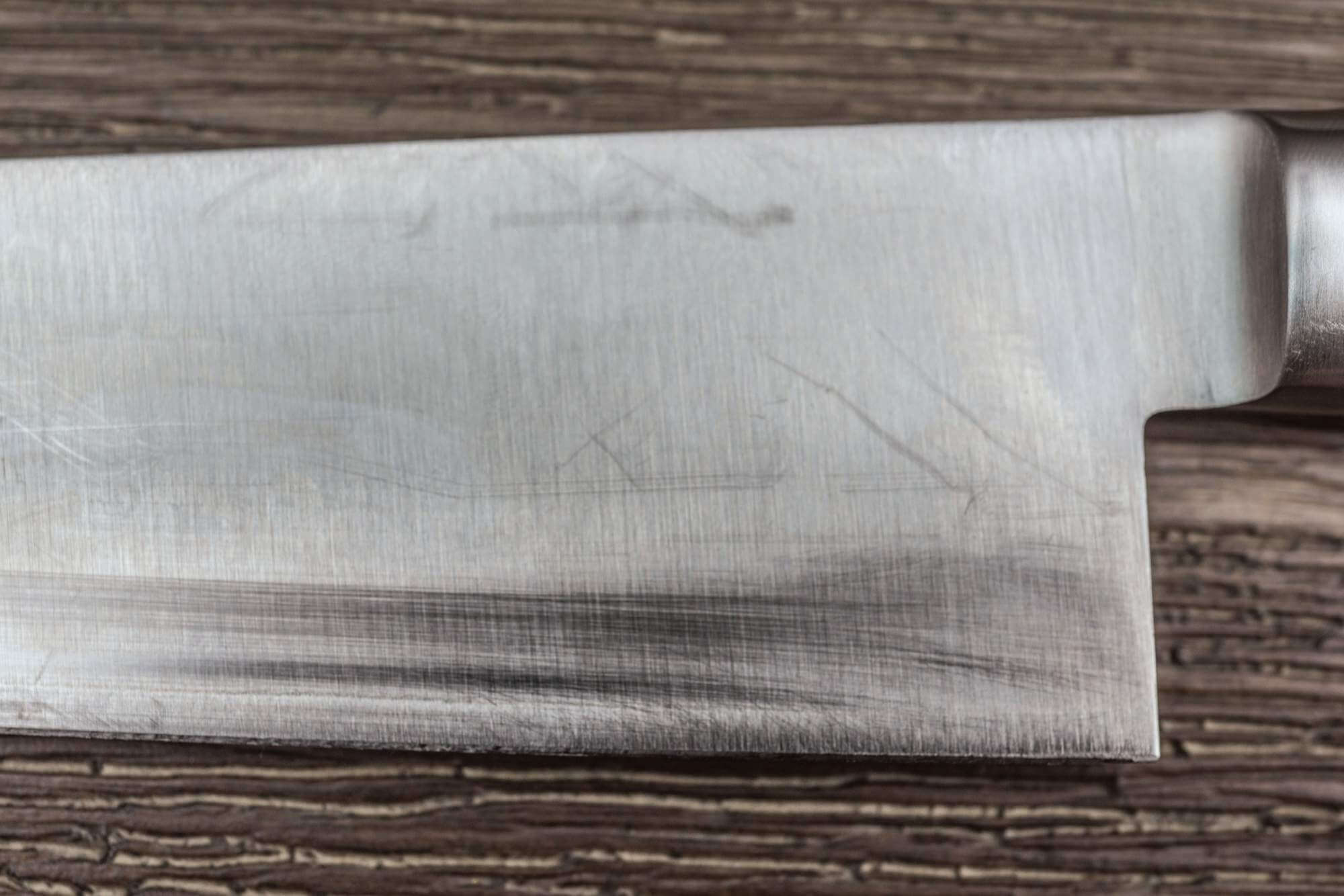
The other downside to Tojiro’s steel choice is that they layer a softer steel on either side of the extra-hard core. This looks kind of neat, but that softer steel is vulnerable to scratches. If you’re using a magnetic knife bar or an electric sharpener, be prepared to see scratches and “snail-trail” marks.
Like the Nexus, this is a blade that’s too thin for some jobs; it’s a symmetrical edge grind, but it’s a refined slicer more than than a work-horse chopper. If you’re accustomed to full-bellied chef’s knives for rocking up and down on the cutting board, this shape will take some getting used to.
The price is also less of a bargain than we’d like. If you’re chasing Japanese-style slicing performance, this is probably still the best place to get it, but the Greater Goods will be a more comfortable knife for many home cooks at a much better price.
Key takeaways:
- The Tojiro – DP is a great pick for a first Japanese-style blade.
- This is an excellent blade for careful work, but less forgiving than our top pick if you’re enthusiastic about chopping.
- The hard VG-10 edge steel is sandwiched between soft side layers, and they scuff easily.
- Other Japanese knives can be had at a better value, but this model is easy to find.
Best German-style knife: Mercer
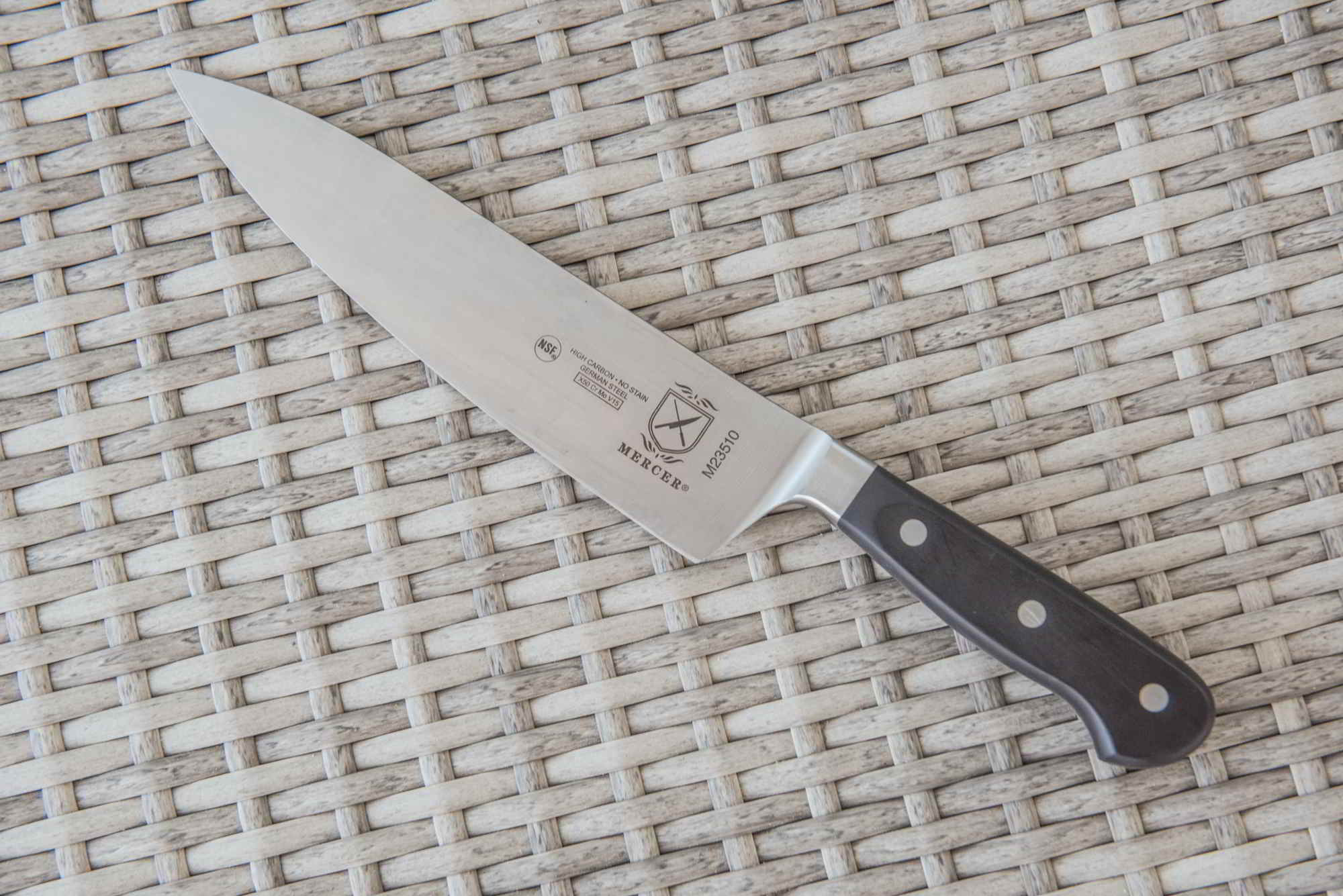
Mercer is one of the most popular knife brands in culinary schools, mostly because they sell prepackaged kits that make one-stop shopping easy and affordable for students. The Renaissance Chef’s knife is Mercer’s full-tang, half-bolster styling, with a look and construction quality that matches the Classic series from Wüsthof but at a significantly lower price.
Best German-style knife: Mercer - Renaissance
If you want an easy-to-maintain knife that will rock-chop through celery and carrots all day, this won't disappoint. The edge is thin and sharp, and the finishing work is impeccable at any price. Mercer doesn't have as much cachet as other names, but they're making great knives.
Mercer gets a bad rap among enthusiasts who prefer the hard steel of Japanese knives, but if you’re looking for a softer, easy-to-maintain knife anyhow, the Renaissance keeps up with the best sub-$100 knives from the European manufacturers.
Chef Hendricksen gave the low-cost Mercer knives his vote for a great way to save money and build a set that focuses on your needs: “I’ve used all sorts of knives. I have been very happy with the Mercer tools. Chefs often have an advantage over others where they can talk to the reps from the knife companies about the intended use and preferences. The reps know that marketing will only last so long and the tools need to do the job. Remember that knives are tools and it’s the cook that makes the food.”
Also best knife set for the money: Mercer
Mercer’s basic block set is attractive and a good value if you actually want every knife it includes. Most of the knives we included in this roundup are available in sets, but Mercer has the widest range of options and the best price for a starter set.
The Nexus Chef-and-paring knife set is a close value contender in our estimation, but we don’t think the other knives in their line are the same bargain as the chef’s knife. (You’re not wearing the edge of your bread knife away against the cutting board, after all.) If you want to mix-and-match your knives, the Nexus pair might be a perfect place to start, but if you want to build a full block with the same styles, Mercer offers a better value.
Block or no block?
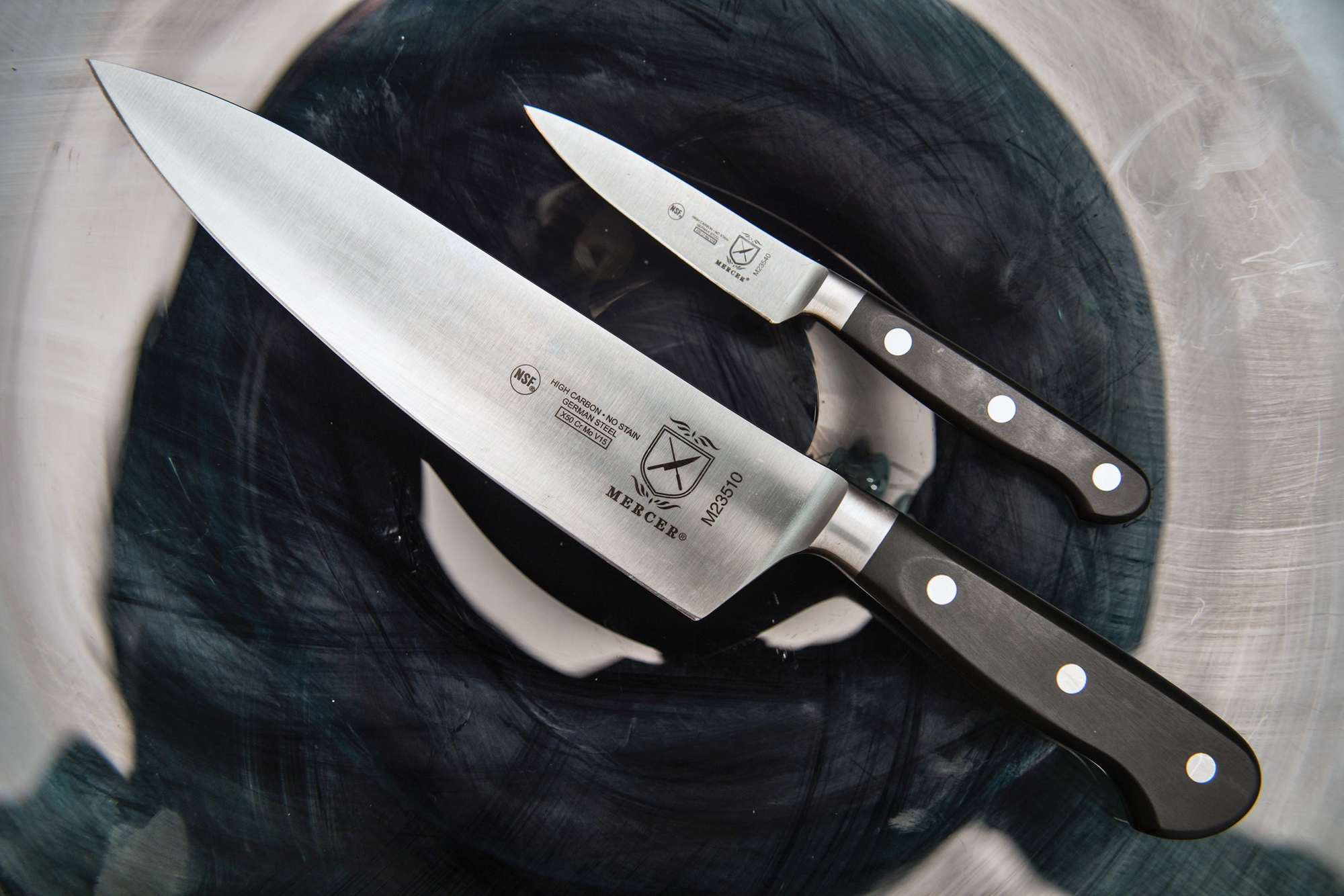
The worst thing about block sets is that they give you an excuse to just pull out a different knife, even a knife that’s badly suited to the task at hand, because you’ve already been using your favorite knife and it’s dirty. There’s nothing wrong with having multiple tools that can do the same job, but most of us don’t need a three-inch, five-inch and six-inch knife in the same set. Fortunately, Mercer makes it easy for you to buy their knives one at a time, still for a great price.
One of our knife experts, Dave Martell, sums up knife blocks like this: “I say put your money into a few really nice knives vs. a whole bunch of mediocre ones.” Most people will be served best by a simple set with the 8″ chef’s knife (or the 10″ if you’ve got room on your cutting board), along with a paring knife and a 10″ or longer serrated bread knife. Martell’s personal standards for “really nice” are probably different than most of ours, but the principle applies if your budget is $50 or $1,000.
Martell also recommended getting a good non-serrated slicing knife for carving, while culinary instructors like Chef Hendricksen like to see a boning knife as a part of a first set. Being able to get knives that fit the way you cook is key.
The option to buy knives that are longer than eight inches is the best reason not to buy a knife set: Manufacturers only started making chef’s knives, slicers and bread knives in eight-inch lengths because it’s so much cheaper to make (and ship) a knife block if it only needs to hold eight-inch knives. The bread knife is the big let-down in the Renaissance block set: it’s only 8 inches. The Mercer – Millennia bread knife doesn’t have a matching handle, but for sawing through a thick loaf the longer 10-inch edge really does help.
One perk of buying one at a time is that you can pick and choose from other manufacturers, too. You could combine Mercer’s bread knife with the Nexus for chopping veggies and a Tojiro Yanagiba for slicing, for example. But if you want a matched set you can still add all the essentials and a few specialty tools from the Mercer – Renaissance line without spending $300+ like you would with more recognizable brands.
If you don’t get your knife set with a block, where will you store them? Wall-mounted magnetic knife storage is an option that doesn’t take up counter space, and can hold basically any combination of knives you prefer. We’ve bought this bar from Modern Innovations and this set with hooks from Unique Effects. This walnut strip from Kurouto is also a good buy — it doesn’t have an ugly logo on the front the way some wooden strips do.
Key takeaways:
- The Mercer – Renaissance knives perform just as well as the big German brands at one third the price.
- The fit and finish on the chef and paring knives is perfect.
- Mercer’s softer steel and thicker edges are easy to maintain, though not as impressive as thinner knives.
- If you want a matched set, the Renaissance series is easy to get with just the pieces you need.
Other finalists we liked
Misono – Molybdenum Gyuto

Misono is one of the mainstays of knifemaking in Seki, Japan. The Misono Molybdenum series (named for the notable alloying element in the steel) is their least-expensive line, but it’s finished with the same attention to detail as their more expensive models.
This knife performed very well in our slicing and edge stability tests. If you’re looking for an extra-thin blade, this one won’t disappoint. The AUS-8 steel is a popular choice for Japanese cutlery; it’s not as wear-resistant as the VG-10 in the Tojiro, but that also means it’s easier to sharpen.
This is another Japanese blade with a sharp corner at the heel; if you’re not expecting a knife to have a sharp edge there, be careful not to catch it on towels when drying. It’s quite easy to round the corner on a cheap sharpening stone if you’re of the opinion that it shouldn’t be so pointy.
The one caveat with this knife (and many other Japanese knives) is that it’s sharpened to an asymmetrical edge: We measured 17 degrees on the left side, 25 degrees on the right. This means it will “steer” slightly to the right if you try to make a long, smooth push-cut, kind of like the way an airplane wing creates lift when slicing through the air. For careful chopping and slicing most food, it works well, but it made some cuts, like peeling potatoes, far more difficult.
Mercer – Millennia

Mercer makes an entire line of Millennia knives for students, commercial kitchens and anyone else who just needs a cheap knife that’s easy to maintain. We’re not going to soften our critique of this knife — the price is low for a reason. These knives use bottom-of-the-barrel X30Cr13 steel that’s even cheaper than the X50CrMoV15 steel used by the big names in mass-produced knives. About the best thing that can be said about this steel is that it’s very easy to sharpen.
That said, the difference between this $15 knife and the OXO or IKEA knife is that it’s actually comfortable to use. The edge is just as thin as the Wüsthof and Victorinox, so this a great slicer when it’s fresh off the sharpener. For slicing through raw yams, this budget-friendly knife actually has top slicing performance.
Best Knife for Less Than $30: Mercer - Millennia
Mercer makes this knife for restaurants and schools who buy them by the dozen. They're not glamorous, but if you keep them sharp they do their job well. The handle is comfortable without getting in the way, and the factory sharpening is set up perfectly for most chopping chores.
The handle on the Millennia is both cushioned and grippy. Pinching the textured sides of the bolster area isn’t quite the same as pinching the sides of the blade in a chef’s pinch-grip, but it’s right at the balance point and gives good control while remaining comfortable. It’s a much easier handle to get used to than the Wüsthof, and this one won’t get in the way when sharpening.
The rest of the finalists

Victorinox – Fibrox
The Fibrox chef’s knife has topped budget-knife lists for as long as we can remember, and it’s a nice knife that knows how to find its place in a busy kitchen.
If the Fibrox were as cheap as it used to be, it would have ranked higher, but Victorinox has started enforcing a “minimum advertised price” policy with online retailers. When you can easily buy the Mercer – Renaissance in the same steel with a nicer full-tang handle and bolster for $10 less, it’s hard to say that the Victorinox is a good value, let alone a bargain.
Made from the same plain old X50CrMoV15 steel that’s used by the rest of the European cutlery industry, about the only thing that’s remarkable about this knife is the grip. The Fibrox material feels grippy and soft without feeling sticky like rubber or silicone grips. The molded bolster is still too far forward for easy use with an electric sharpener, but it’s not as bad as the Wüsthof.
Wüsthof – Pro Cook’s Knife
The Wüsthof – Pro Cook’s Knife is one of the more unique designs in the budget bracket. The belly radius of the edge is fuller than most, which makes it good for rock-chopping. The blade is sharpened well and ground to a nice, thin edge, and there’s a buffed wavy-mirror polish on the sides of the blade that give it a bit of distinction.
The handle is a grippy, rubbery material that’s molded to stay in your hand no matter what. That said, the molded bolster gets in the way if you prefer a pinch-grip, and it prevents sharpening all the way to the heel if you’re using an electric sharpener.
Like the Victorinox, this could be a good budget pick if it were actually budget-priced. When we bought our test lineup it was twice as expensive as the Mercer – Millennia, and only $7 less than the traditional looks and construction of the Mercer – Renaissance. If you find one on sale for $20, it’s a good utilitarian knife, but don’t expect more than that.
Tramontina – Pro Chef’s Knife
Tramontina makes their Pro Chef’s knife with a drop-forge process just like all the big-name manufacturers used to do fifty years ago. These methods and styling have largely disappeared from Germany as automation has made stamping and welding cheaper (and cleaner) than forging, but the giant old-world presses are still pounding away in Brazil.
This is the thickest, heaviest knife we tested. The blade is actually ground thinner behind the edge than the other Euro-style knives from Wüsthof, Victorinox or Mercer, but the spine is thick and the full bolster brings the balance point almost an inch toward the handle side. The out-of the box sharpening was below-average, though this steel is as easy to sharpen as any you’ll find.
If you like having a full bolster (for… opening cans?) and a heavy knife for smashing through vegetables, this isn’t a bad choice. The steel is finished just a touch harder than the other Euro-style knives, which was a nice surprise, but the fit and finish is not good enough to earn it a recommended pick. At this end of the price range, we still think most people will prefer the Mercer – Renaissance.
OXO – Good Grips Pro
We like many OXO products, but their Good Grips – Pro Chef’s knife is a great example of form before function. All of the specs are there: full tang, half-bolster, quality German steel and a profile that’s good for rock-chopping. Despite the smooth molded handle and flawless finish, though, the crisp spine and bolster edges just aren’t comfortable in extended use.
Worse still, the OXO has the thickest blade of any we tested. Slicing yams, even after re-sharpening the edge, was just too much work. The one positive quality of this blade is that the thick edge angle helps keep veggies from sticking to the face of the blade when making thin slices of cucumber and potato.
IKEA – 365+
The new IKEA 365+ chef’s knife is like many IKEA products: a good attempt that isn’t executed as well as it could have been. We’d heard good things about a past IKEA knife, but the new 365+ just tries to look like a Global G2 without actually feeling good in the hand.
Sadly, the IKEA handle is just too narrow to be comfortable over extended cutting sessions. Worse, there was a telltale brown scorch mark near the tip, evidence that someone overheated the edge when sharpening. The edge is thick, too, so slicing performance was subpar.
The premise of a $20 one-piece knife in “molybdenum-vanadium” stainless made us hopeful, but whoever IKEA chose to make this knife for them did not follow through. If you like stainless handles and want to try thinning out this blade on a waterstone, at least it wouldn’t be an expensive experiment.
The bottom line
A kitchen knife is a tool that can become an extension of your hand, turning raw ingredients on a cutting board into food that you can enjoy cooking. Knife buying doesn’t have to be complicated, but finding a good balance of cost, easy maintenance and materials that will hold a sharper edge for longer can really turn your kitchen chef’s knife from a tool you loathe into a tool you love.
We set a fairly low budget for our lineup in this review, since most people will be much better served spending more on a sharpening tool than on a high-end knife that’s still going to become dull after a month of use. Check out our knife sharpener review for solutions that will keep your blades at peak performance.
We really love the performance of the Nexus 8″ Chef’s knife, and we think it’s an excellent buy. In a unique feat, the innovative use of a brand-new steel means this edge is both durable and easy to sharpen. The handle materials are bomb-proof, and the blade is ground to a high-performance slicing edge.
For those of us who don’t need more than a solid, versatile knife to use in a small kitchen, the Greater Goods – Nourish 0556 is an even better value. It’s made from top-tier Japanese steel, but the weight and handle design help it feel comfortable and secure even in novice hands. It’s a great-looking blade at a great price, and the included magnetic mounting stud makes this a one-stop purchase for a first step into better knife skills.
Finally, if you want a conventional-looking knife with a German-style blade, the Mercer – Renaissance is a chef’s knife that will serve you just as well as it has served thousands of culinary students across the country. Better still, you can easily build a set of matching kitchen knives from Mercer’s catalog, and expand your collection as you need it without being shackled to a clunky, dirty knife block like most overpriced knife sets.
Top Pick: Nexus - BD1N
This is a great knife in almost every way. The new nitrogen-alloyed steel is basically perfect for kitchen use, with a balance of toughness and hardness. The handle and finishing aren't perfect, but the sharpening, materials and price are all spot-on. You'll have to spend $130 or more to find a knife that can really compete with the Nexus.
More Reviews
The 8 Best Electric Egg Cookers
Elite Gourmet - EGC-007B
The 8 Best Salt and Pepper Grinders
Merazi Living
Blue Apron
Martha & Marley Spoon
HelloFresh Meal Delivery Kit Review
HelloFresh
OXO - 3-Blade Tabletop
Klean Kanteen - 20-Ounce Insulated
Coleman - 9-Can Soft Cooler


